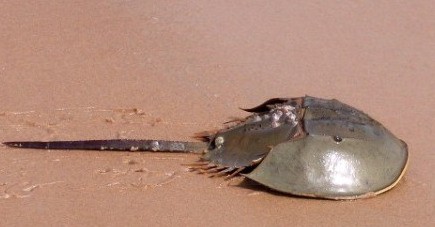Mahakalapara: An endangered marine creature, horseshoe crab, is on the verge of extinction allegedly due to rampant smuggling to foreign countries by some unscrupulous traders, a report said.
The rare marine creature is in danger. The crabs are being pushed into extinction despite their tenacity in surviving around 450 million years. There are four types of the marine creature found in the Pacific and Indian oceans. However, two types of horseshoe crabs are found in the marshy mangrove forest and sandcast areas on the state’s coast.
Moreover, the movement of mechanised fishing boats, trawlers and use of plastic nets for fishing has also proved detrimental to the population of this endangered species.
Two species of the horseshoe crab are abundantly found migrating to breed regularly along the coast of the state. But unregulated fishing activities along the coast and lack of awareness among the local fishermen about the crab’s economic importance are leading to their dwindling population. Every year, horseshoe crabs die in large numbers after getting entangled in fishing nets near the Madali mouth.
These crabs are found in large numbers in the Gahirmatha sanctuary of Mahakalapara block, Hukitola Island in the Bhitarkanika sanctuary, Madali sea mouth, Launchghola of Kendrapara district and in rivers and creeks flowing in the Mahanadi delta region.
However, off late the survival of these crabs is under serious threat. Environmentalists apprehend if urgent steps are not taken then the day is not far-off when this creature will get extinct from our state.
Reports said that horseshoe crabs are claimed to be living on this planet even before the advent of dinosaurs. A medical analysis conducted in 2019 stated that horseshoe crabs have been living on this planet for more than 30 crore years and have survived four mass extinction events for which they have been classified as a living fossil.
The blood of these crabs contains copper instead of iron. Horseshoe crabs use a chemical called hemocyanin to carry oxygen through their blood. Because of the copper present in hemocyanin, their blood is blue.
Their blood contains amebocytes, which plays a similar role to that of white blood cells of vertebrates in defending the organism against pathogens. The chemical present in their blood helps in detecting disease in the blood of the humans. These crabs have been observed lying in the marshy lands of mangrove forest, river and creeks and in sandy areas.
The mating of these crabs usually takes place on new moon night and full moon night when hoards of crabs could be seen moving towards the sea beach. Pair of crabs could be seen mating on the beach from November till February. The blood of these crabs is used in preparing medicines for dreaded diseases like cancer. The Gahirmatha sanctuary is a safe breeding place for these crabs.
When contacted, environmentalist Samarendra Mahali said that the blue blood of the horseshoe crab is used in preparation of medicines for many dreaded diseases for which the Forest department should take adequate steps for their security and growth of their populations. This apart, the fishermen should be taught on the importance of these crabs and their protection, he added.
PNN
